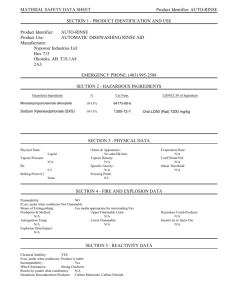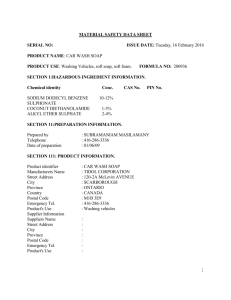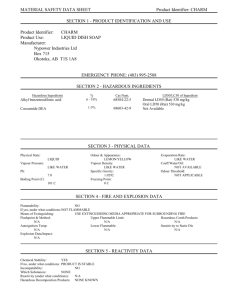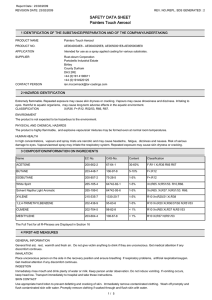SAFETY DATA SHEET SANDTEX TRADE METAL GLOSS X-TRA
advertisement
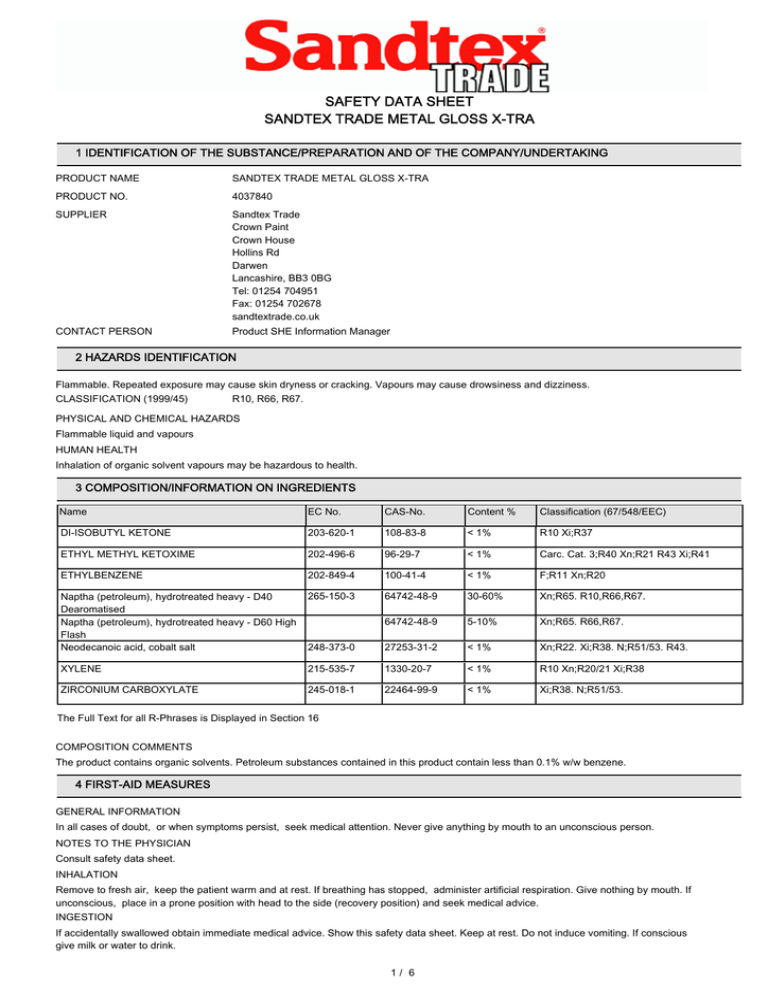
SAFETY DATA SHEET SANDTEX TRADE METAL GLOSS X-TRA 1 IDENTIFICATION OF THE SUBSTANCE/PREPARATION AND OF THE COMPANY/UNDERTAKING PRODUCT NAME SANDTEX TRADE METAL GLOSS X-TRA PRODUCT NO. 4037840 SUPPLIER Sandtex Trade Crown Paint Crown House Hollins Rd Darwen Lancashire, BB3 0BG Tel: 01254 704951 Fax: 01254 702678 sandtextrade.co.uk CONTACT PERSON Product SHE Information Manager 2 HAZARDS IDENTIFICATION Flammable. Repeated exposure may cause skin dryness or cracking. Vapours may cause drowsiness and dizziness. CLASSIFICATION (1999/45) R10, R66, R67. PHYSICAL AND CHEMICAL HAZARDS Flammable liquid and vapours HUMAN HEALTH Inhalation of organic solvent vapours may be hazardous to health. 3 COMPOSITION/INFORMATION ON INGREDIENTS Name EC No. CAS-No. Content % Classification (67/548/EEC) DI-ISOBUTYL KETONE 203-620-1 108-83-8 < 1% R10 Xi;R37 ETHYL METHYL KETOXIME 202-496-6 96-29-7 < 1% Carc. Cat. 3;R40 Xn;R21 R43 Xi;R41 ETHYLBENZENE 202-849-4 100-41-4 < 1% F;R11 Xn;R20 Naptha (petroleum), hydrotreated heavy - D40 Dearomatised Naptha (petroleum), hydrotreated heavy - D60 High Flash Neodecanoic acid, cobalt salt 265-150-3 64742-48-9 30-60% Xn;R65. R10,R66,R67. 64742-48-9 5-10% Xn;R65. R66,R67. 248-373-0 27253-31-2 < 1% Xn;R22. Xi;R38. N;R51/53. R43. XYLENE 215-535-7 1330-20-7 < 1% R10 Xn;R20/21 Xi;R38 ZIRCONIUM CARBOXYLATE 245-018-1 22464-99-9 < 1% Xi;R38. N;R51/53. The Full Text for all R-Phrases is Displayed in Section 16 COMPOSITION COMMENTS The product contains organic solvents. Petroleum substances contained in this product contain less than 0.1% w/w benzene. 4 FIRST-AID MEASURES GENERAL INFORMATION In all cases of doubt, or when symptoms persist, seek medical attention. Never give anything by mouth to an unconscious person. NOTES TO THE PHYSICIAN Consult safety data sheet. INHALATION Remove to fresh air, keep the patient warm and at rest. If breathing has stopped, administer artificial respiration. Give nothing by mouth. If unconscious, place in a prone position with head to the side (recovery position) and seek medical advice. INGESTION If accidentally swallowed obtain immediate medical advice. Show this safety data sheet. Keep at rest. Do not induce vomiting. If conscious give milk or water to drink. 1/ 6 SANDTEX TRADE METAL GLOSS X-TRA SKIN CONTACT Remove contaminated clothing. Wash skin thoroughly with soap and water or use a proprietary skin cleaner. Do not use solvents or thinners. EYE CONTACT Contact lenses should be removed. Irrigate copiously with clean, fresh water for at least 10 minutes, holding the eyelids apart, and seek medical advice. 5 FIRE-FIGHTING MEASURES EXTINGUISHING MEDIA Extinguish with alcohol-resistant foam, carbon dioxide, dry powder or water fog. Do not use water jet. SPECIAL FIRE FIGHTING PROCEDURES Cool closed containers exposed to fire with water spray. Do not allow run-off from fire fighting to enter drains or water courses. UNUSUAL FIRE & EXPLOSION HAZARDS No unusual fire or explosion hazards noted. SPECIFIC HAZARDS Fire will produce dense black smoke containing hazardous products of combustion (see section10). Decomposition products may be hazardous to health. PROTECTIVE MEASURES IN FIRE Appropriate self-contained breathing apparatus may be required. 6 ACCIDENTAL RELEASE MEASURES PERSONAL PRECAUTIONS Exclude sources of ignition and ventilate the area. Floors may become slippery. Warn others of the dangers present and exclude non-essential personnel. Refer to protective measures listed in sections 7 and 8. Avoid breathing vapours. ENVIRONMENTAL PRECAUTIONS Do not allow to enter drains or water courses. If the product enters drains or sewers the local water company should be contacted immediately; in the case of contamination or streams, rivers or lakes, the Environment Agency. SPILL CLEAN UP METHODS Contain and collect spillages with non-combustible absorbent materials, e.g. sand, earth, vermiculite, diatomaceous earth and place in a clearly labelled suitable container for disposal in accordance with the waste regulations (see section 13). Clean preferably with a detergent; avoid the use of solvents. 7 HANDLING AND STORAGE USAGE PRECAUTIONS Solvent vapours are heavier than air and may spread along floors. They may form explosive mixtures with air. For personal protection, see section 8. Avoid skin and eye contact. Avoid inhalation of vapour. Prevent the creation of flammable or explosive concentrations of vapour in air and avoid vapour concentrations higher than the occupational exposure limits. Additionally, the product should only be used in areas from which all naked lights and other sources of ignition have been excluded. Electrical equipment should be protected to the appropriate standard. Keep the container tightly closed. Exclude sources of heat, sparks and open flame. Smoking, eating and drinking should be prohibited in areas of storage and use. Never use pressure to empty; the container is not a pressure vessel. Always keep in the same material as the supply container. Good housekeeping standards and regular safe removal of waste materials will minimise risks of spontaneous combustion and other fire hazards. The Manual Handling Operations Regulations may apply to the handling of containers of this product. Packs with a volume content of 5 litres or more may be marked with a maximum gross weight. To assist employers the following method of calculating the weight for any pack size is given. Take the pack size volume in litres and multiply this figure by the specific gravity value given in section 9. This will give the net weight of the coating in kilograms. Allowance will then have to be made for the immediate packaging to give an approximate gross weight. USAGE DESCRIPTION Use product only in accordance with methods listed in section 1. STORAGE PRECAUTIONS Although the storage of this product is not subject to specific statutory requirements, the principles contained in HSE guidance note HS(G)51 'Storage of Flammable liquids in Containers' should be observed. Observe the label precautions. Store between 5°C and 30°C in a dry, well ventilated place away from sources of heat, ignition and direct sunlight. No smoking. STORAGE CLASS The storage of this product is not subject to any statutory requirements. 8 EXPOSURE CONTROLS/PERSONAL PROTECTION 2/ 6 SANDTEX TRADE METAL GLOSS X-TRA Name STD TWA - 8 Hrs STEL - 15 Min DI-ISOBUTYL KETONE WEL 25 ppm 148 mg/m3 ETHYLBENZENE WEL Naptha (petroleum), hydrotreated heavy - D40 Dearomatised Naptha (petroleum), hydrotreated heavy - D60 High Flash XYLENE WEL 100 ppm(Sk) 197 ppm 441 mg/m3(Sk) 1200 mg/m3 125 ppm(Sk) No std. 552 mg/m3(Sk) No std. WEL 197 No std. 1200 No std. ppm mg/m3 WEL 50 ppm(Sk) 220 mg/m3(Sk) 100 ppm(Sk) 441 mg/m3(Sk) Notes WEL = Workplace Exposure Limit. INGREDIENT COMMENTS LT = Long term exposure limit. ST = Short term exposure limit. TWA = Time weighted average. Ppm = Parts per million Mgm-3 = Milligrams per cubic metre. Sk = Indicates a risk of absorption through skin. PROTECTIVE EQUIPMENT PROCESS CONDITIONS Special precautions should be taken during surface preparation of pre-1960's paint surfaces over wood and metal as they may contain harmful lead. All engineering control measures used to control exposure to hazardous substances must be selected, maintained, examined and tested to meet the requirements of the Control Of Substances Hazardous to Health regulations (COSHH). Similarly all personal protective equipment, including respiratory protective equipment, must be selected, issued and maintained to meet the requirements of COSHH. These requirements include the provision of any necessary information, instruction and training with regard to their use. ENGINEERING MEASURES Provide adequate ventilation. Where reasonably practicable this should be achieved by the use of local exhaust ventilation and good general extraction. If these are not sufficient to maintain concentrations of solvent vapour below the relevant workplace exposure limits, suitable respiratory protection should be worn. (See personal protection below). Dry sanding, flame cutting and/ or welding of the dry paint film will give rise to dust and/ or hazardous fumes. Wet sanding should be used wherever possible. If exposure cannot be avoided by the provision of local exhaust ventilation, suitable respiratory protective equipment should be worn. RESPIRATORY EQUIPMENT If exposure to hazardous substances identified above cannot be controlled by the provision of local exhaust ventilation and good general extraction, suitable respiratory protective equipment should be worn. Where high levels of solvent vapour are likely to arise (e.g. confined spaces) air fed respiratory protective equipment should be worn. HAND PROTECTION When skin exposure may occur wear gloves. Advice should be sought from glove suppliers on appropriate types. Barrier creams may help to protect exposed areas of the skin but are not substitutes for full physical protection. They should not be applied once exposure has occurred. Always wash your hands before eating smoking or using the toilet. EYE PROTECTION Eye protection designed against liquid splashes should be worn. OTHER PROTECTION Should not be necessary under normal conditions of use. HYGIENE MEASURES Always wash your hands before eating, smoking or using the toilet. PERSONAL PROTECTION See PPE listed above. SKIN PROTECTION Cotton or cotton/ synthetic overalls or coveralls are normally suitable. Grossly contaminated clothing should be removed and the skin washed with soap and water or a proprietory skin cleaner. ENVIRONMENTAL EXPOSURE CONTROLS See section 12. 9 PHYSICAL AND CHEMICAL PROPERTIES APPEARANCE Viscous liquid COLOUR Range of colours ODOUR Characteristic SOLUBILITY Immiscible with water 3/ 6 SANDTEX TRADE METAL GLOSS X-TRA BOILING POINT (°C) BULK DENSITY VAPOUR DENSITY (air=1) VAPOUR PRESSURE VISCOSITY FLASH POINT (°C) AUTO IGNITION TEMPERATURE (°C) FLAMMABILITY LIMIT - LOWER(%) FLAMMABILITY LIMIT - UPPER(%) 149 - 213 0.913 g/l >4.5 0.4 kPa @ 15 °C 3.1 Pas @ 23 °C 38 Sh CC (Setaflash closed cup). 230 - 270 0.6 6 10 STABILITY AND REACTIVITY STABILITY Stable under the recommended storage and handling conditions (see section 7). CONDITIONS TO AVOID Protect from frost, heat and sunlight. MATERIALS TO AVOID Keep away from oxidising agents and strongly alkaline and strongly acidic materials to prevent the possiblility of exothermic reaction. HAZARDOUS DECOMPOSITION PRODUCTS In a fire, hazardous decomposition products such as smoke, carbon monoxide, carbon dioxide and oxides of nitrogen may be produced. 11 TOXICOLOGICAL INFORMATION GENERAL INFORMATION Exposure to organic solvent vapours in excess of the stated workplace exposure limit may result in adverse effects on the liver renal and central nervous systems. INHALATION Exposure through inhalation may result in the following effects: headache, dizziness, fatigue, muscular weakness, drowsiness and in extreme cases, loss of consciousness. INGESTION Ingestion may result in the following effects: sore throat, abdominal pain, drowsiness, nausea, vomiting and diarrhoea. Other effects may be described as for exposure to vapours. SKIN CONTACT Solvents may cause the above effects by exposure through the skin. Repeated or prolonged contact with the product may lead to removal of natural fats from the skin resulting in non-allergic contact dermatitis and absorption through the skin. EYE CONTACT Splashes in the eyes may cause irritation and reversible local damage. HEALTH WARNINGS At elevated temperature, may release 2-butanone oxime/ ethyl methyl ketoxime, which is classified as a category 3 carcinogen and as a skin sensitiser. 12 ECOLOGICAL INFORMATION ECOTOXICITY These products have been assessed following the conventional method and are not classified as dangerous for the environment but contain substances dangerous for the environment. See section 3 for details. The product should not be allowed to enter drains or watercourses or be deposited where it can affect ground or surface waters. The Air Pollution Control requirements of regulations made under the Environmental Protection Act may apply to the use of this product. 13 DISPOSAL CONSIDERATIONS GENERAL INFORMATION When this coating, in its liquid state, as supplied or skinned, becomes a waste, it is categorised as hazardous waste, with code 08 01 11 (list of wastes). Part used containers, not drained and/ or rigorously scraped out and containing dried residues of the supplied coating, are categorised as non-hazardous waste, with code 08 01 12 (list of wastes). Used containers, drained and/ or rigorously scraped out and containing dried residues of the supplied coating, are categorised as non-hazardous waste, with code 15 01 02 or 15 01 04 (list of wastes). If mixed with other wastes, the above waste code may not be applicable. DISPOSAL METHODS Do not allow into drains or water courses or dispose of where ground or surface waters may be affected. 14 TRANSPORT INFORMATION 4/ 6 SANDTEX TRADE METAL GLOSS X-TRA PROPER SHIPPING NAME PAINT ENVIRONMENTALLY HAZARDOUS SUBSTANCE/MARINE POLLUTANT UN NO. ROAD No. ADR CLASS NO. 3 ADR CLASS Class 3: Flammable liquids. ADR PACK GROUP III TUNNEL RESTRICTION CODE (D/E) HAZARD No. (ADR) 30 ADR LABEL NO. 3 HAZCHEM CODE •3YE UN NO. SEA 1263 IMDG CLASS 3 IMDG PACK GR. III EMS F-E, S-E UN NO. AIR 1263 AIR CLASS 3 AIR PACK GR. III 1263 15 REGULATORY INFORMATION RISK PHRASES R10 Flammable. R66 Repeated exposure may cause skin dryness or cracking. R67 Vapours may cause drowsiness and dizziness. S2 Keep out of the reach of children. S37 Wear suitable gloves. S46 If swallowed, seek medical advice immediately and show this container or label. S51 Use only in well-ventilated areas. S56 Dispose of this material and its container to hazardous or special waste collection point. P14 Contains ETHYL METHYL KETOXIME,Neodecanoic acid, cobalt salt. May produce an allergic reaction. SAFETY PHRASES UK REGULATORY REFERENCES The products are classified and supplied in accordance with the Chemicals (Hazard Information Packaging for supply) regulations (CHIP). The information contained in this safety data sheet does not constitute the user's own assessment of workplace risks as required by other health and safety legislation. The provision of the Health and Safety at Work Act and the Control of Substances Hazardous to Health regulations apply to the use of this product at work. EU DIRECTIVES Dangerous Substance Directive 67/548/EEC. Dangerous Preparations Directive 1999/45/EC. Regulation (EC) No 1907/2006 of the European Parliament and of the Council of 18 December 2006 concerning the Registration, Evaluation, Authorisation and Restriction of Chemicals (REACH), establishing a European Chemicals Agency, amending Directive 1999/45/EC and repealing Council Regulation (EEC) No 793/93 and Commission Regulation (EC) No 1488/94 as well as Council Directive 76/769/EEC and Commission Directives 91/155/EEC, 93/67/EEC, 93/105/EC and 2000/21/EC, including amendments. Classification, labelling and packaging of substances and mixtures 1272/2008EC APPROVED CODE OF PRACTICE Approved classification and labelling guide (Sixth edition) The compilation of safety data sheets (Third edition) GUIDANCE NOTES Workplace Exposure Limits EH40. Storage of Flammable Liquids in Containers, HS(G)51 Storage of Packaged Dangerous Substances, HS(G)71 5/ 6 SANDTEX TRADE METAL GLOSS X-TRA NATIONAL REGULATIONS The Control Of Substances Hazardous to Health regulations (as amended) The Manual Handling Operations regulations (as amended) The Environmental Protection (Duty of Care) regulations (as amended) The Chemicals (Hazard Information and Packaging) for supply regulations (as amended) The Health and Safety at Work act 1974 (as amended) 16 OTHER INFORMATION GENERAL INFORMATION The information contained in this safety data sheet is provided in accordance with the requirements of the regulations. The product should not be used for purposes other than those shown in section 1 without first referring to the supplier and obtaining written handling instruction. As the specific conditions of use of the product are outside the suppliers control, the user is responsible for ensuring that the requirements of relevant legislation are complied with. REVISION COMMENTS This information is provided in a revised format to that previously produced. ISSUED BY Product SHE Information Manager REVISION DATE 02/03/2011 RISK PHRASES IN FULL R10 Flammable. R20/21 Harmful by inhalation and in contact with skin. R20 Harmful by inhalation. R22 Harmful if swallowed. R21 Harmful in contact with skin. R65 Harmful: may cause lung damage if swallowed. R11 Highly flammable. R37 Irritating to respiratory system. R38 Irritating to skin. R40 Limited evidence of a carcinogenic effect. R43 May cause sensitisation by skin contact. R66 Repeated exposure may cause skin dryness or cracking. R41 Risk of serious damage to eyes. R51/53 Toxic to aquatic organisms, may cause long-term adverse effects in the aquatic environment. R67 Vapours may cause drowsiness and dizziness. DISCLAIMER The information provided in this safety data sheet is based on the present state of knowledge and current national legislation. It provides guidance on health and safety and environmental aspects and should not be construed as any guarantee of technical performance or suitablility for particular applications. 6/ 6

